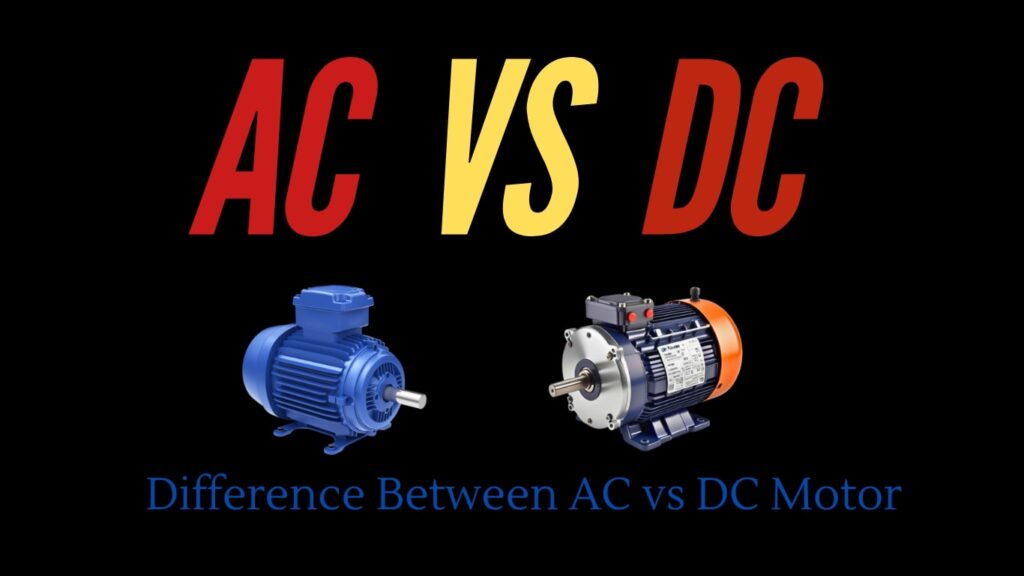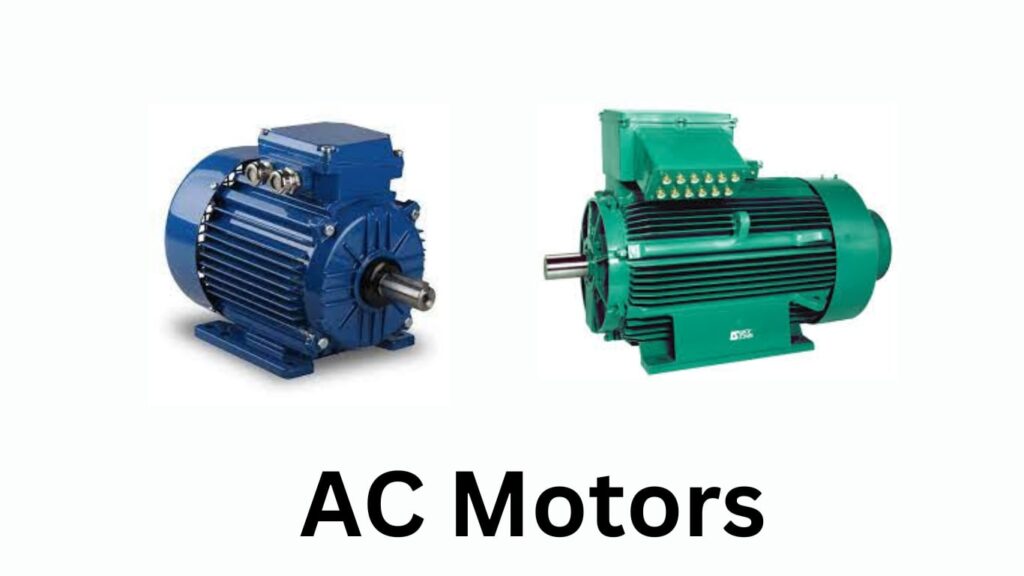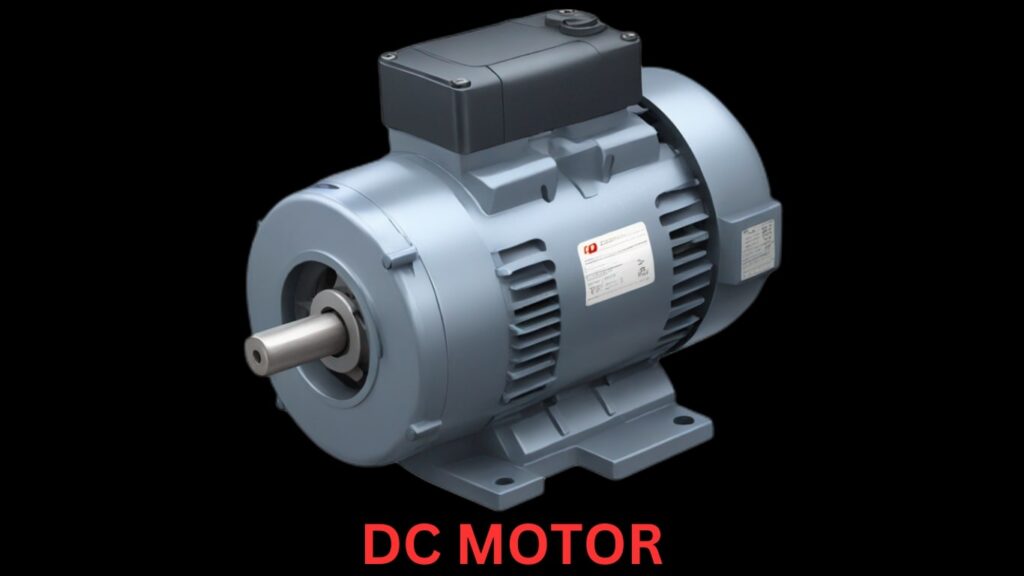AC vs DC Motor
In general, motors are the core components of electric devices and convert electrical energy into mechanical energy. Of these motors, AC vs DC motors are the ones that few of us would not be able to encounter. There will certainly be some obsolescent functions in the electric technology and there will be ways to improve it. However, this article explains how AC vs DC motor units works, with the aim to help you decide which one is more appropriate for your needs.

What does an AC Motor mean?
An AC motor runs on alternating current. The operation of an AC motor is quite simple in the fact that in the presence of a magnetic field when an electric current is passed through a specific medium (usually a wire), that wire experiences some force. This force generates rotational movement in the rotor, which is the moving part of the motor. It is worth mentioning that it is easy to use, very reliable, and can withstand high voltage, which is common among AC motors.
For industries, the major benefit of employing AC motors as opposed to their direct current counterparts is that mechanical devices are put into motion without the aid of complicated circuitry and other components. Because of the high degree of efficiency of the motor in the conversion of energy and the capacity to conduct high-load applications, this makes it well-suited for the industrial application.
What does an DC Motor mean?
Direct current (DC) is used to drive a DC motor, which means current can only move in one direction. It is safe to say that the basic principle is not much different with the AC motor, in which a magnetic field and electric current produce a force that rotates the rotor. A special feature of the construction of DC motors is the commutator that changes the current direction, allowing constant torque to be delivered. DC motors are very useful because they have excellent speed control and fast response. This is ideal for applications requiring very fine motor control such as in robotics where speed needs to be controlled.
AC vs DC Motor – A Comparative Study
| Feature | AC Motor | DC Motor |
| Current Type | Alternating Current (AC) | Direct Current (DC) |
| Speed Control | Complex and less precise | Simple and highly precise |
| Efficiency | High efficiency at higher loads | Higher efficiency at low to medium loads |
| Initial Cost | Lower | Higher due to additional components |
| Maintenance | Low | High due to brushes and commutator |
| Applications | Industrial, HVAC, pumps, conveyors | Robotics, electric vehicles, small appliances |
While both AC vs DC motors are designed to convert electrical energy into mechanical energy, their differences in current type, speed control, and applications set them apart. AC motors excel in heavy-duty applications, while DC motors are ideal for precision tasks.
AC Motors:
AC motors usually consist of two main parts the stator and the rotor. The stator causes the formation of a rotating magnetic field around which a current is induced in the rotor which makes it rotate with. The construction is so uncomplicated, and the simplification off the layout has caused the need for the brushes to be hardly any making these motors less prone and simple designs and wearing.

DC Motors:
DC motors are considered complex machines. A rotor, a stator, a commutator, and brushes make up the rotors. The users of the brushes push against the commutators, leading to a change in the current flow through the rotor windings. This change guarantees the continuity of the rotational direction of the rotor. Nevertheless, such design results in increased mechanical failure and more servicing compared to AC motors.

Types : AC vs DC Motor
AC Motors Classifications:
Synchronous Motors:
The Synchronous motors operate at a set speed at all times and are efficient. Auxiliary means are used for the magnetic field in service as its maintenance is required and thus these find usage in areas where there is a need for more control in speed.
Induction Motors:
Also ac called as cage motor, which does not require slip ring and brushes, is ubiquitous type of motor in industries. Self starting, Not Maintenance- intense in nature, Suited to a wide range of industry. These Motors are mounted below in a shaft of fans, pumps, conveyor.
DC Motors Classifications:
Shunt Wound Motor:
These are construction with constant speed and torque irrespective of load which makes them suitable for constant speed usages such as conveyors.
Series Wound Motor:
These are used in situations that require high torque such as elevators and Crain’s but the speeds are not constant and hence they vary with the load.
Permanent Magnet DC Motor:
These are small motors best suited in applications such as toys and as parts of automotive systems. They provide a good amount of maximum efficiency for low load applications.
Speed Control and Efficiency Between AC vs Dc motor
AC Motors:
For the case of control of velocity of AC motor, this is normally more difficult and so extra apparatus stands the chance of being added in the form of frequency inverters or variable frequency drives (VFDs). Such devices modify the input frequency and voltage in order to affect the speed of the motor. The accuracy is nowhere near that of DC motors but the performance at higher speeds and higher loads is better.
DC Motors:
Most advantages of speed regulation attribute to the construction of the DC motor. There is always a linear relationship between the armature voltage and the speed of a DC motor. This means that if the armature voltage is increased; the speed increases too. Hence regulation of speed is easily accomplished by employing simple methods. It is therefore not surprising that this high precision of control made DC motors most satisfactory for work involving speed changes. In terms of efficiency, AC motors are the best in high load applications hence outperforming the DC motors but when it comes to low to medium load applications, the opposite holds true and this can be said of DC motors.
Applications of AC vs DC motor:
Applications of AC Motors
The presence of alternating current (AC) motors in the application areas can be associated with high voltage handling capability and high efficiency on heavy loads. The following is a few of such uses:
• HVAC systems: AC motors drives fans and compressors used in heating, ventilating and on air conditioner systems.
• Industrial Machinery: AC motors are frequently used in Tile conveyers, pumps and machine tools since they are more reliable, and take less time in high load utilization.
• Household Appliances: AC motors are used in washing machines, air conditioners and refrigerators because they are reliable with a long life and minimal maintenance.
In a nutshell, wherever application demands uninterrupted operations and varying speeds or voltages can be endured, then AC Motors come to play.
Applications of DC Motors
DC motors operate best under conditions where speed control, rapid responses and variable load changes are critical. Here are few examples:
• Electric Vehicles: In electric vehicles, especially cars, trains and even forklift trucks, there is the utilization of DM motors where high torque is required but precision is also very critical.
• Robotics: DC motors are very suitable for robotic applications that require movement or rotation in a precise manner.
• Small Apparatus: There are several battery-operated gadgets such cordless drills, children’s toys and electric razors that utilized DC Motor since its lightweight and simple for mobile use.
Particular non-submersible DC motors are used where fine control and high acceleration, especially at low voltages are required.
Advantages and Disadvantages of AC vs Dc motor
AC Motors:
Advantages:
• They are cheap to purchase
• They have a straightforward and tough construction
• They perform excellently at high extreme loading situations
• Less servicing is required as there are no brushes
Disadvantages:
• It is hard to control the speed
• At low loads, there are losses of efficiencies
DC Motors:
Advantages:
• They have very good speed control characteristics and respond quickly
• They are very efficient at subnormal and medium loads
• They are appropriate for use in processes that demand accuracy
Disadvantages:
• High capital investment
• Processes intending to keep this machine in a good working condition need regular cleansing because of the brushes and commutator ..
• Limited practicality in high load situations with no intricate networks for control design
Which motor is better for your application? (AC vs DC motor)
The selection of either AC vs DC motor is determined by the requirements of the application. AC motors are reliable, powerful and self-contained for industrial requirements that involve working at high efficiency with heavy loads. Their design allows for much effortless operation and shifting of equipment but incorporates low cost in servicing, making them ideal for use in HVAC systems, machines, and home appliances.
On these specific applications however, DC motors are quite impressive particularly in terms of speed and precision management. This is well-suited for applications such as electric vehicles, robotics and small size appliances due to its fast response and effective use at low to medium loads.
For harsh environments, high power and applications for longer periods of duty, an AC motor is recommended. If there is a need for more control especially in low powered devices then the DC motor will be the ideal choice.
To learn more about AC vs DC motor visit and feel free to contact us. Read our latest article about Magneto Motive Force (MMF): The Ultimate Guide to Electromagnetic Efficiency
Conclusion:
In conclusion, having the knowledge of the differences between AC vs Dc motor, it would be wise to build the right motor for the right application. It may be to the extreme of power, the extreme of speed or efficiency both, motor types have some strength which can be utilized in any of those factors depending on the motion intended.
FAQs (People Also Ask About AC vs DC Motor)
Q1. What is the fundamental difference between AC vs DC motors?
Both types of motors are quite similar in functionality, but when it comes to their construction and working principles, they are completely different machines. The difference mainly comes down to how each motor starts. Each motor works on the basis of wire coils rotating inside magnetic fields. The magnetic fields in the AC motor change direction on a regular basis while the DC motor runs off a single direction magnetic field.
Q2. How do AC and DC motors work?
Single phase induction motors, 3-phase induction motors, universal motors, etc. all fall under the category of AC motors and they work in alternate current. The start AC motors are connected through AC electricity supply. On the other hand, the standard components of a DC motor are a commutator, brushes, and an armature along with direct current running through the system, causing an electromagnetic field that will interact with another fixed magnetic field to create propulsion.
Q3.Which is more efficient: AC vs DC motor?
However, this isn’t to say that one motor is better than the other, it depends on the application because, for example, the efficiency of a DC motor is superior when it comes to applications with slow or variable speed but when it comes down to high speed and constant load scenarios, an AC motor especially the induction type, will most likely be more efficient.
Q4.What are the main applications of AC vs DC motors?
AC motors are commonly found in home appliances, HVAC systems, industrial machinery, and in other large applications where constant speed is needed. For tasks that require speed control such as robotics, electric vehicles, and smaller devices like toys or handheld tools, DC motors are ideal.
Q5.Why do AC motors not require brushes, while DC motors do?
AC motors do not require brushes since they utilize the AC current in order to directly produce a rotating magnetic field. This is different for DC motors where commutators transfer current to the rotating armature with the assistance of brushes, for a switch to be operational, unidirectional current must flow.
Q6.What are the advantages of DC motors over AC motors?
DC motors are effective when it comes to speed and torque control and are therefore best suited for applications where fine adjustment control is necessary. Moreover, they start with high torque which is perfect for heavy load applications, their design also enables rotation at low speeds much more smoothly than AC motors.
Q7. What types of loads are best suited for AC vs DC motors?
Its better to use AC motors for constant speed applications with slight changes in load such as fans, pumps and conveyor belts. DC motors on the other hand, are well suited for applications requiring variable speed and high amount of torque, for instance, electric cars, lifts, or other industrial equipment requiring a hefty amount of precision.
Q8.How do AC vs DC motors differ in terms of speed control?
Controlling speed in a DC motor is easy as it can be done by varying the input voltage or current. In control of Speed problems, DC micro motors will use much more complex systems such as a variable frequency drive, that changes the frequency of a supply current.
Q9.Are AC motors more durable than DC motors?
Since there are no brushes or commutators that would eventually erode, AC motors are seamlessly easier to maintain which makes them significantly tough and low maintenance. These motors work great for high-pressure long-lasting tasks.
Q10.What is the role of a commutator in DC motors, and why is it absent in AC motors?
The role of a commutator in DC-motor operation is to ensure that the current is directed through the armature in one direction, thereby assuring that the necessary magnetic interaction for motion takes place. ACs on the other hand do not need commutators since an alternating current does naturally induce the rotating magnetic field.
Q11.Which motor has lower maintenance requirements, AC or DC?
AC motors don’t involve older components like brushes and commutators which wear out in DC motors so they are said to have less maintenance. This makes more advisable the use of AC motor drives for critical applications where downtime has to be minimized.
Q12.How do power requirements vary between AC vs DC motors?
The AC motors are more suitable for high voltage three phase systems and are more toward industrial power grids. The opposite is true for DC motors, which function more efficiently at low voltages making them useful for systems and devices powered by batteries.
Q13.Which motor is cheaper to manufacture: AC vs DC?
In general, AC electric motors are less expensive to construct and install in mass applications due to their less complicated structure which doesn’t require brushes and commutators, among other components. On the contrary because of the construction complexity, which does not favor volume applications of standardized machines, the use of DC motors could be more economical for individual or near individual applications.
Q14.How do the operational costs of AC vs DC motors compare?
Operational costs depend on usage. It is observed that AC motors have better efficiency and lesser maintenance during the case of constant speed application, on the other hand, for DC motors may be a frequent maintenance, However, variable speed application can get benefits from energy savings due to the precision.
Q15.What factors influence the energy efficiency of AC vs DC motors?
Such factors are the load type, speed of operation and control logic. The case of DC motors are very efficient in low speed and high torque applications, whereas for AC motors, any application with variable frequency drives reduces the speed efficiency.
Q16.Are modern industries moving towards AC or DC motors? Why?
A majority of the industry is using more of AC motors, due to development such as VFD which has improved the AC motors in speed control. At the same time, however, the renewable energy boom and electric vehicles also created a new opportunity of using DC motors again as well, particularly in battery-powered applications.
Q17.What are the latest technological advancements in AC and DC motors?
In the case of AC the remarkable development includes VFDs and more flattened induction motor structures. In the case of DC brushless designs are innovations that reduced wear and maintenance. Material progress is also improving for both types with high-performance magnets and insulation.
Q18.How has the development of variable frequency drives (VFDs) affected the use of AC motors?
The development of VFDs made it easier to control AC motors, which could have promised to outperform DC motors in almost every aspect. With this, the VFD has made it possible to employ the use of AC motors in areas requiring different range of speeds.
Q19.Which motor is better for industrial applications: AC or DC?
AC motors are the preferred type of motor for industrial purposes because of their strength, efficiency, and capabilities to perform power-intensive tasks. Nevertheless, there are still applications of DC motors that require high start-up torque or more accuracy and specific controls.
Q20.Why are DC motors often used in electric vehicles (EVs)?
For EVs, powering a vehicle with a DC motor makes it easier for the driver to control torque and speed which varies greatly with the speed of the vehicle. Amongst all others, the BLDC has gained popularity as it is efficient, reliable, and compact in size.
Q21.What makes AC motors ideal for home appliances?
When you consider home appliances that operate on AC electricity, an AC motor is an excellent choice because of its simplicity, reliability, and cost-efficiency. With such motors, devices like refrigerators, washing machines, and fans can work perfectly such that they do not require any modifications.
